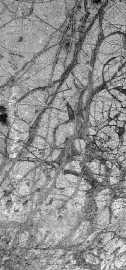This is an image of Europa showing what may be plates floating on a subsurface ocean.
Click on image for full size
NASA
Does Europa have a Surface in Motion?
The surface of Europa was carefully examined for signs of pushing and shoving which the crust of Europa has undergone through time. By identifying the "pushing forces", scientists can figure out how the surface of Europa moves.
Europa shows many signs of volcanism, where water flows like lava, such as:
- smooth plains
- puddle-like flow
- floods (see puddle-like flow)
- plates (example shown here)
- earthquake faulting (similar to the San Andreas Fault of Earth)
This type of surface is different from either that of Callisto or Ganymede. (The other major moon of Jupiter, Io has many volcanoes.) The difference has to do with heating inside of Europa
You might also be interested in:
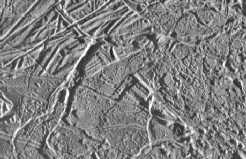
This is an example of the surface of Europa. The surface may be flooded by fresh water from underground, which freezes when it touches the surface. The edges of the flow are rounded, like a puddle of water
...more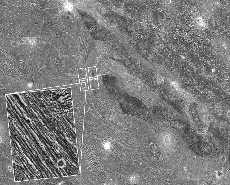
There has been no icy volcanism on Ganymede, nor continental drift, but it does seem that there have been movements of the surface. Examination of the surface of Ganymede reveals many kinds of faulting.
...more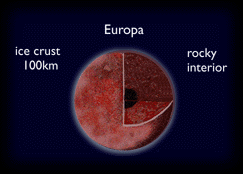
The diagram to the left shows the possible interior of Europa. The composition of the icy moons is mostly ice, therefore there is probably a small core of rocky material buried inside, covered with ice.
...more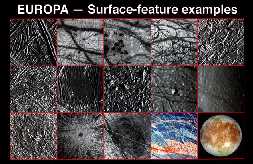
Many exciting discoveries were made about Europa during the Galileo mission. The surface of Europa is unusual, even for an icy moon. It appears that the surface is pretty new, rather than being ancient.
...more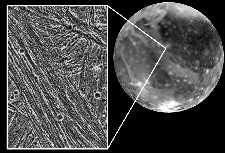
Instead of icy-volcanism, the surface of Ganymede reveals a gradual surface stretching which is similar to the crustal stretching of the Earth. In this case, the folding and stretching of the crust of
...more
Amalthea was discovered by E Barnard in 1872. Of the 17 moons it is the 3rd closest to Jupiter. Amalthea is about the size of a county or small state. Amalthea is named after the goat in Greek mythology
...more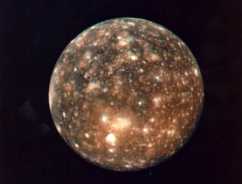
Callisto was first discovered by Galileo in 1610. It is the 2nd largest moon in the solar system, and is larger than the Earth's moon. It is about as big as the distance across the United States. Callisto
...more


